Quasi-Situ Characterization of Retained Austenite Orientation in Quenching and Partitioning Steel via Uniaxial Tensile Tests
Abstract
1. Introduction
2. Materials and Methods
3. Results and Discussion
3.1. Microstructures and Quantitative Metallography Analysis
3.2. Macroscopic Stress-Displacement Responses
3.3. Evolution of the Global RA Fraction with Deformation
3.4. Evolution of the RA with Typical Orientation
4. Conclusions
- The volume fraction of global RA decreases linearly with the increase of deformation. When the displacement increases from 0 mm to 1.05 mm, the volume fraction of global RA decreases from 9.4% to 6.6% according to EBSD data.
- The (111) and (311) grains account for the highest proportion of RA in the undeformed sample (3.8% and 3.4%, respectively). Simultaneously, the latter has higher mechanical stability when the material is deformed.
- It was observed from quasi-situ typical textures distribution maps of RA that the deformation resulted in the rotation of the RA grain. Meanwhile, the RA grains are more inclined to (311) orientation with higher mechanical stability. At the same time, the work hardening rate of the material remains low at the strain stage when the RA grains rotation occurs significantly.
Author Contributions
Funding
Acknowledgments
Conflicts of Interest
References
- Jacques, P.; Furnémont, Q.; Lani, F.; Pardoen, T.; Delannay, F. Multiscale mechanics of TRIP-assisted multiphase steels: I. Characterization and mechanical testing. Acta Mater. 2007, 55, 3681–3693. [Google Scholar] [CrossRef]
- Wang, Y.; Geng, H.; Zhu, B.; Wang, Z.; Zhang, Y. Carbon Redistribution and Microstructural Evolution Study during Two-Stage Quenching and Partitioning Process of High-Strength Steels by Modeling. Materials 2018, 11, 2302. [Google Scholar] [CrossRef] [PubMed]
- Speer, J.; Streicher, A.; Matlock, D.; Rizzo, F.; Krauss, G. Quenching and partitioning: A fundamentally new process to create high strength trip sheet microstructures. Austenite Form. Decompos. Proc. Symp. 2003, 502–522. Available online: https://www.researchgate.net/publication/279555627_Quenching_and_partitioning_A_fundamentally_new_process_to_create_high_strength_trip_sheet_microstructures (accessed on 16 October 2020).
- Liu, C.; Peng, Q.; Xue, Z.; Wang, S.; Yang, C. Microstructure and Mechanical Properties of Hot- Rolled and Cold-Rolled Medium-Mn TRIP Steels. Materials 2018, 11, 2242. [Google Scholar] [CrossRef]
- Chen, Y.; Wang, H.; Cai, H.; Li, J.; Chen, Y. Role of Reversed Austenite Behavior in Determining Microstructure and Toughness of Advanced Medium Mn Steel by Welding Thermal Cycle. Materials 2018, 11, 2127. [Google Scholar] [CrossRef]
- Basuki, A.; Aernoudt, E. Influence of rolling of TRIP steel in the intercritical region on the stability of retained austenite. J. Mater. Process. Technol. 1999, 89, 37–43. [Google Scholar] [CrossRef]
- Jimenez-Melero, E.; van Dijk, N.; Zhao, L.; Sietsma, J.; Offerman, S.; Wright, J.; van der Zwaag, S. Martensitic transformation of individual grains in low-alloyed TRIP steels. Scr. Mater. 2007, 56, 421–424. [Google Scholar] [CrossRef]
- Song, C.; Yu, H.; Li, L.; Zhou, T.; Lu, J.; Liu, X. The stability of retained austenite at different locations during straining of I&Q&P steel. Mater. Sci. Eng. A 2016, 670, 326–334. [Google Scholar]
- Wang, C.; Chang, Y.; Yang, J.; Cao, W.; Dong, H.; Wang, Y. Work hardening behavior and stability of retained austenite for quenched and partitioned steels. J. Iron Steel Res. Int. 2016, 23, 130–137. [Google Scholar] [CrossRef]
- Ding, R.; Dai, Z.; Huang, M.; Yang, Z.; Zhang, C.; Chen, H. Effect of pre-existed austenite on austenite reversion and mechanical behavior of an Fe-0.2 C-8Mn-2Al medium Mn steel. Acta Mater. 2018, 147, 59–69. [Google Scholar] [CrossRef]
- Long, X.; Zhang, R.; Zhang, F.; Du, G.; Zhao, X. Study on quasi-in-situ tensile deformation behavior in medium-carbon carbide-free bainitic steel. Mater. Sci. Eng. A 2019, 760, 158–164. [Google Scholar] [CrossRef]
- Zhao, J.; Zhang, F. In-situ observation of tensile deformation and retained austenite transformation behaviors in carbide-free bainitic steel. Mater. Sci. Eng. A 2020, 771, 138637. [Google Scholar] [CrossRef]
- De Moor, E.; Lacroix, S.; Clarke, A.J.; Penning, J.; Speer, J. Effect of retained austenite stabilized via quench and partitioning on the strain hardening of martensitic steels. Metall. Mater. Trans. A 2008, 39, 2586–2595. [Google Scholar] [CrossRef]
- Devaraj, A.; Xu, Z.; Abu-Farha, F.; Sun, X.; Hector, L. Nanoscale solute partitioning and carbide precipitation in a multiphase trip steel analyzed by atom probe tomography. JOM 2018, 70, 1752–1757. [Google Scholar] [CrossRef]
- Coryell, J.; Savic, V.; Hector, J.; Mishra, S. Temperature effects on the deformation and fracture of a quenched-and-partitioned steel. SAE Tech. Pap. 2013, 24, 1–14. [Google Scholar]
- Tanaka, M.; Choi, C. The Effects of Carbon Contents and Ms Temperatures on the Hardness of Martensitic Fe-Ni-C Alloys. Trans. Iron Steel Inst. Jpn. 1972, 12, 16–25. [Google Scholar] [CrossRef]
- Gao, P.; Chen, W.; Li, F.; Ning, B.; Zhao, Z. New crystallography insights of retained austenite transformation in an intercritical annealed quenching and partitioning steel. Mater. Lett. 2020, 127955. [Google Scholar] [CrossRef]
- Fu, B.; Yang, W.; Wang, Y.; Li, L.; Sun, Z.; Ren, Y. Micromechanical behavior of TRIP-assisted multiphase steels studied with in situ high-energy X-ray diffraction. Acta Mater. 2014, 76, 342–354. [Google Scholar] [CrossRef]
- Liang, J.; Zhao, Z.; Tang, D.; Ye, N.; Yang, S.; Liu, W. Improved microstructural homogeneity and mechanical property of medium manganese steel with mn segregation banding by alternating lath matrix. Mater. Sci. Eng. A 2018, 711, 175–181. [Google Scholar] [CrossRef]
- Tsuchiyama, T.; Tobata, J.; Tao, T.; Nakada, N.; Takaki, S. Quenching and partitioning treatment of a low-carbon martensitic stainless steel. Mater. Sci. Eng. A 2012, 532, 585–592. [Google Scholar] [CrossRef]
- Li, W.; Gao, H.; Nakashima, H.; Hata, S.; Tian, W. In-situ EBSD study of deformation behavior of retained austenite in a low-carbon quenching and partitioning steel via uniaxial tensile tests. Mater. Charact. 2016, 118, 431–437. [Google Scholar] [CrossRef]
- Knijf, D.; Foejer, C.; Kestens, L.; Petrov, R. Factors influencing the austenite stability during tensile testing of Quenching and Partitioning steel determined via in-situ Electron Backscatter Diffraction. Mater. Sci. Eng. A 2015, 638, 219–227. [Google Scholar] [CrossRef]
- Ma, D.; Yang, P.; Gu, X.; Onuki, Y.; Sato, S. In-situ neutron diffraction investigation on the martensite transformation, texture evolution and martensite reversion in high manganese TRIP steel. Mater. Charact. 2020, 163, 110244. [Google Scholar] [CrossRef]
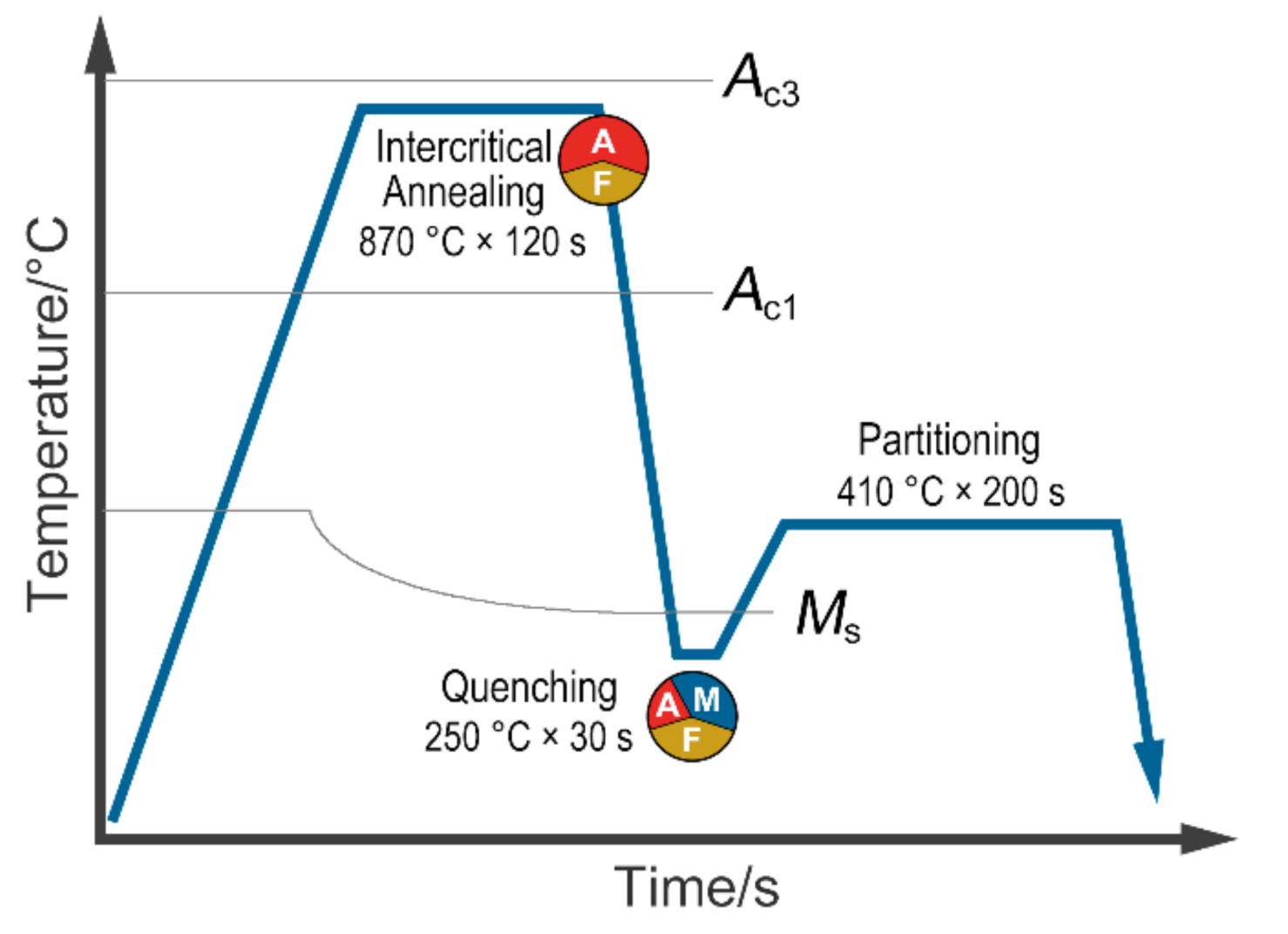
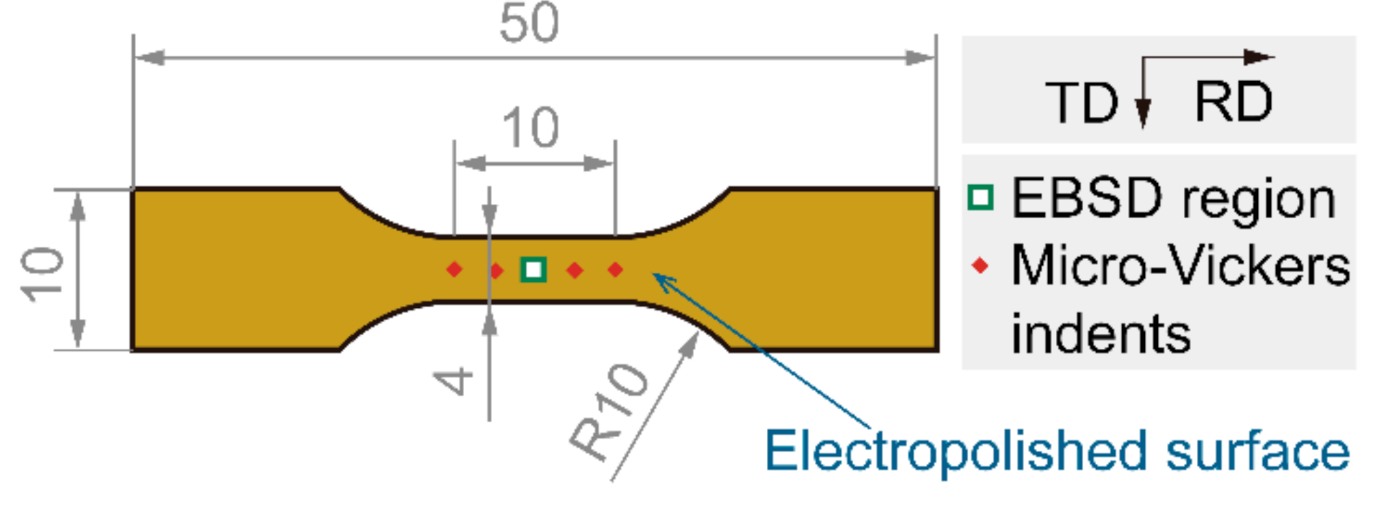
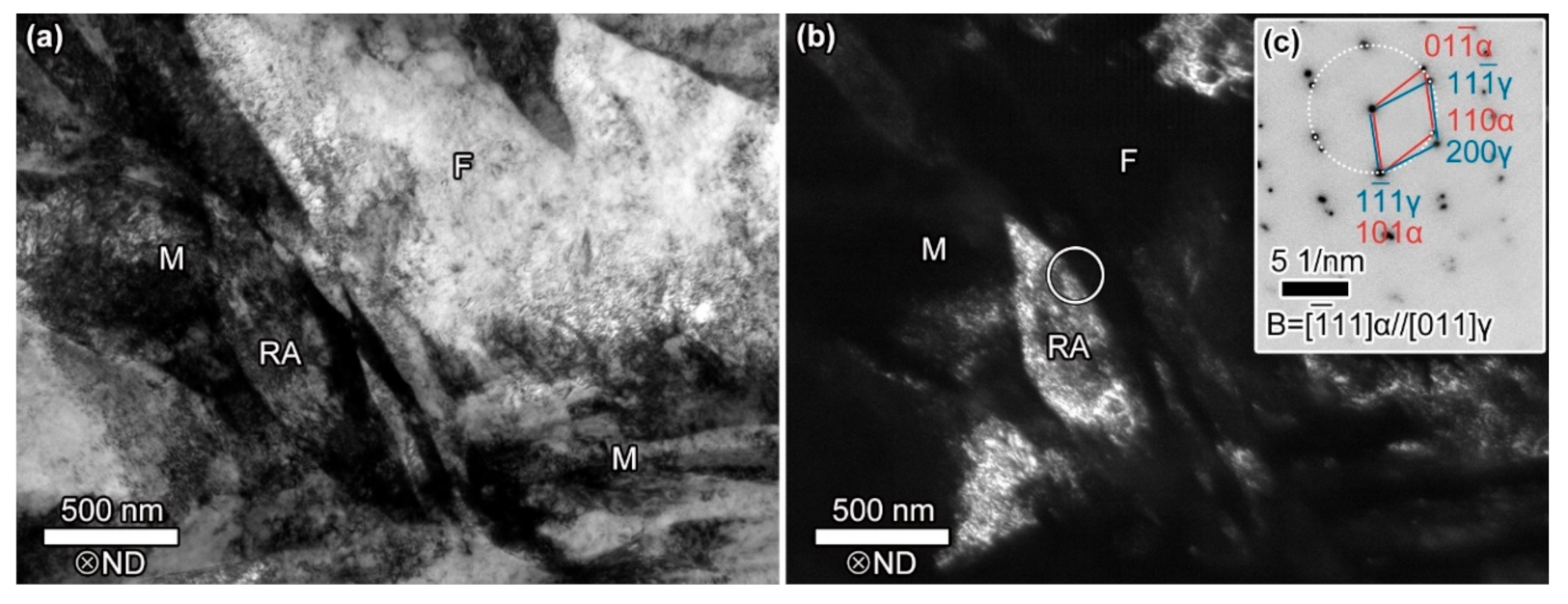


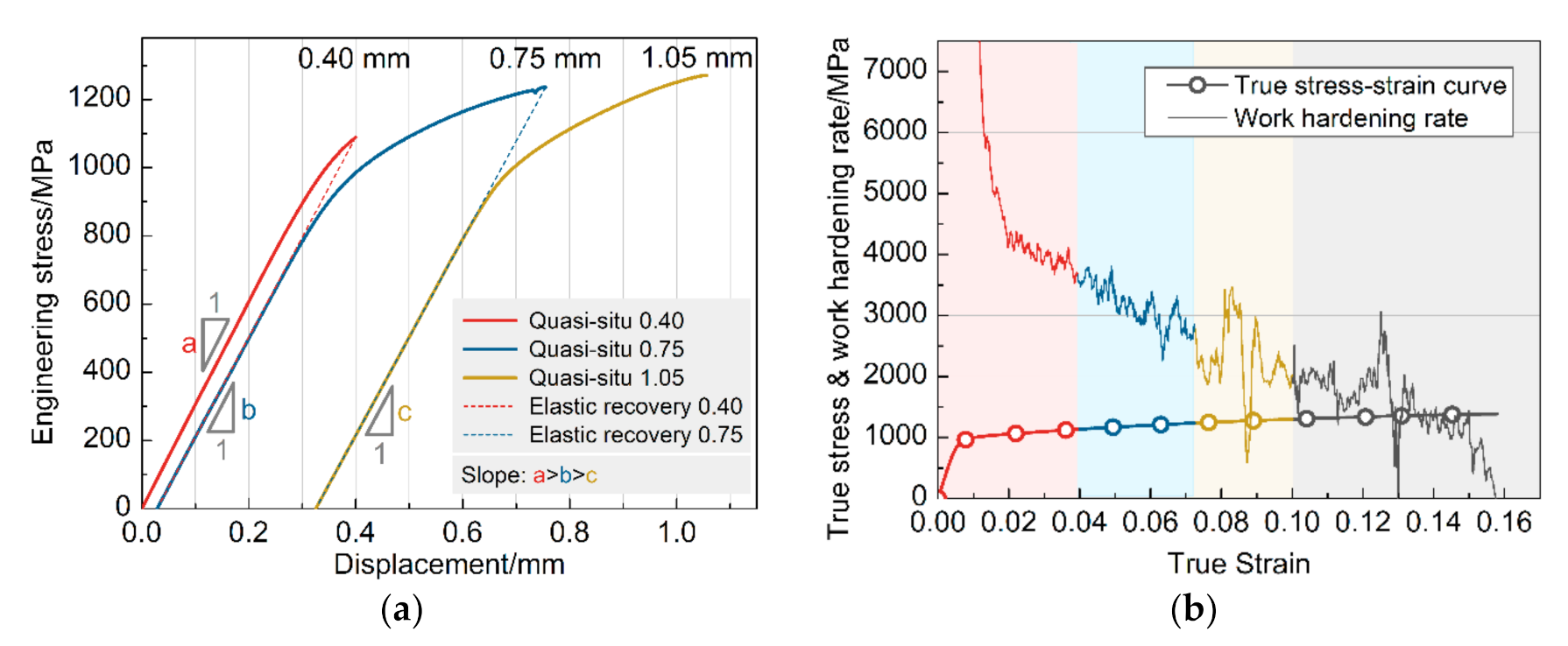
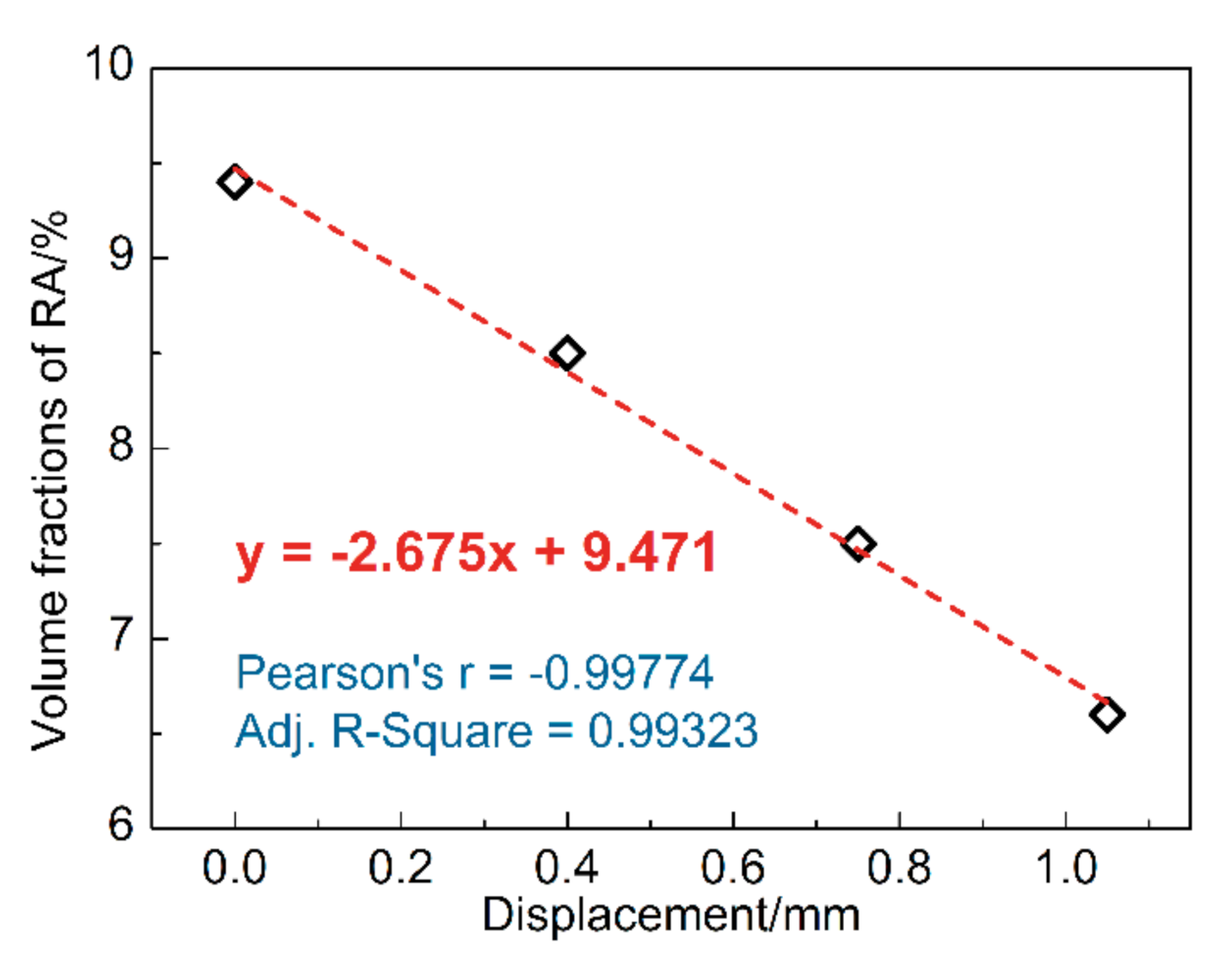
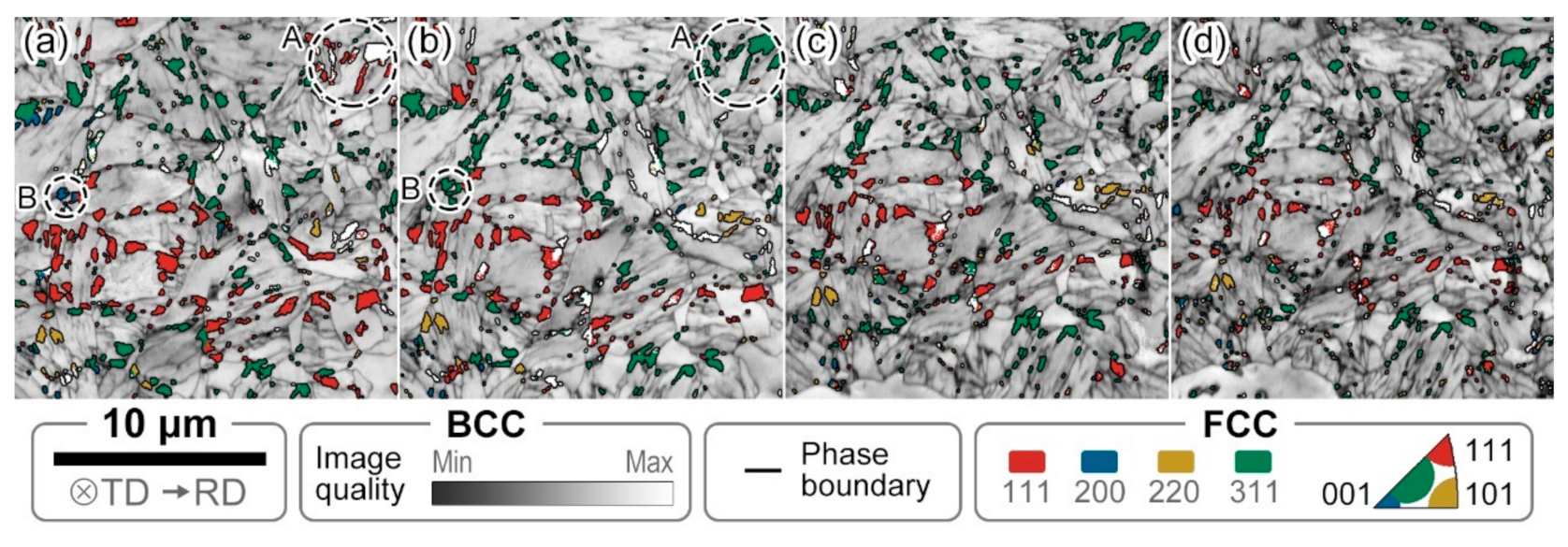
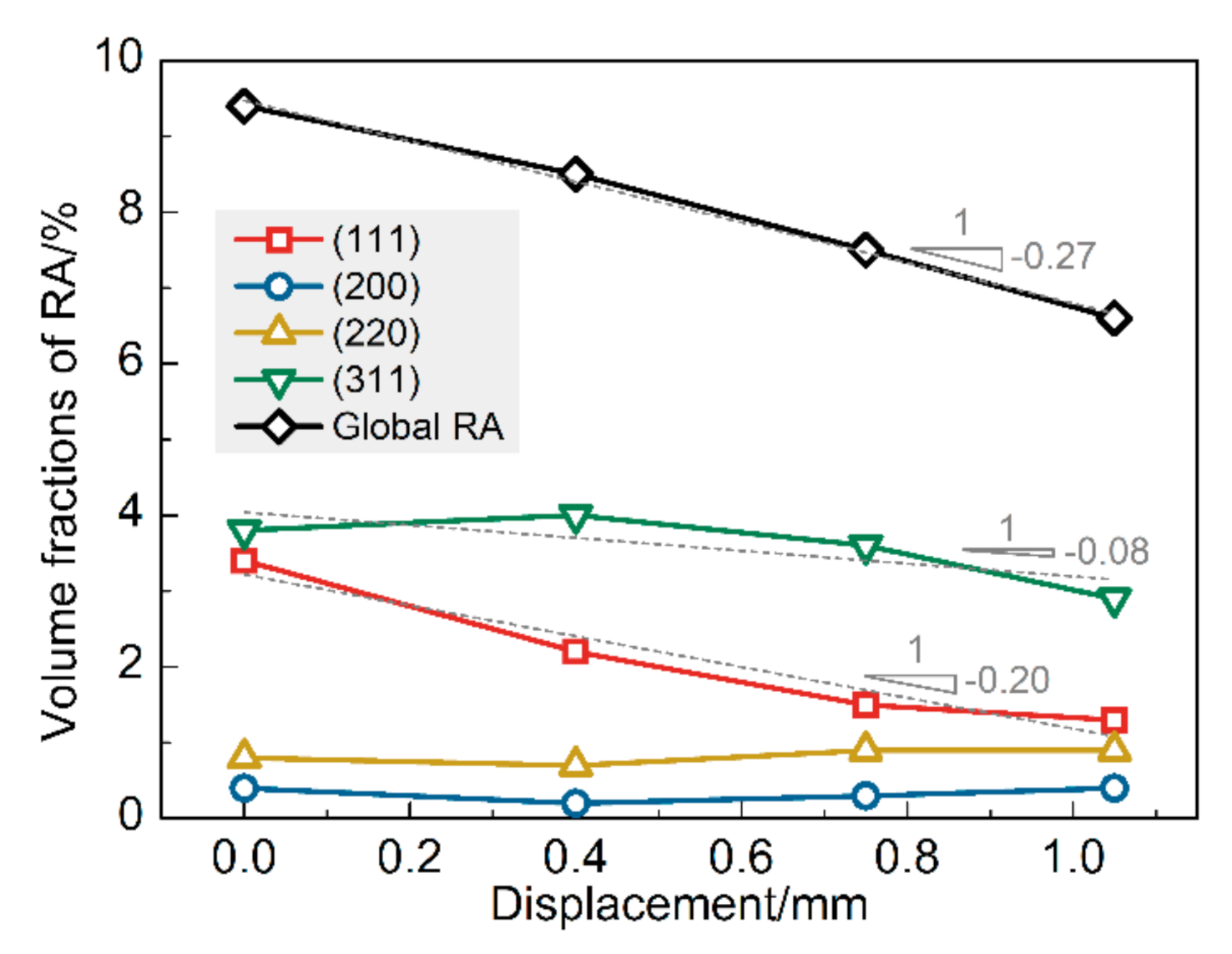

| C | Si | Mn | Fe |
|---|---|---|---|
| 0.18–0.22 | 1.50–2.0 | 2.10–2.70 | Balance |
| Retained Austenite | Ferrite | Martensite |
|---|---|---|
| 11.4 | 18.1 | 70.5 |
Publisher’s Note: MDPI stays neutral with regard to jurisdictional claims in published maps and institutional affiliations. |
© 2020 by the authors. Licensee MDPI, Basel, Switzerland. This article is an open access article distributed under the terms and conditions of the Creative Commons Attribution (CC BY) license (http://creativecommons.org/licenses/by/4.0/).
Share and Cite
Gao, P.; Liu, J.; Chen, W.; Li, F.; Pang, J.; Zhao, Z. Quasi-Situ Characterization of Retained Austenite Orientation in Quenching and Partitioning Steel via Uniaxial Tensile Tests. Materials 2020, 13, 4609. https://doi.org/10.3390/ma13204609
Gao P, Liu J, Chen W, Li F, Pang J, Zhao Z. Quasi-Situ Characterization of Retained Austenite Orientation in Quenching and Partitioning Steel via Uniaxial Tensile Tests. Materials. 2020; 13(20):4609. https://doi.org/10.3390/ma13204609
Chicago/Turabian StyleGao, Pengfei, Jie Liu, Weijian Chen, Feng Li, Jingyu Pang, and Zhengzhi Zhao. 2020. "Quasi-Situ Characterization of Retained Austenite Orientation in Quenching and Partitioning Steel via Uniaxial Tensile Tests" Materials 13, no. 20: 4609. https://doi.org/10.3390/ma13204609
APA StyleGao, P., Liu, J., Chen, W., Li, F., Pang, J., & Zhao, Z. (2020). Quasi-Situ Characterization of Retained Austenite Orientation in Quenching and Partitioning Steel via Uniaxial Tensile Tests. Materials, 13(20), 4609. https://doi.org/10.3390/ma13204609






